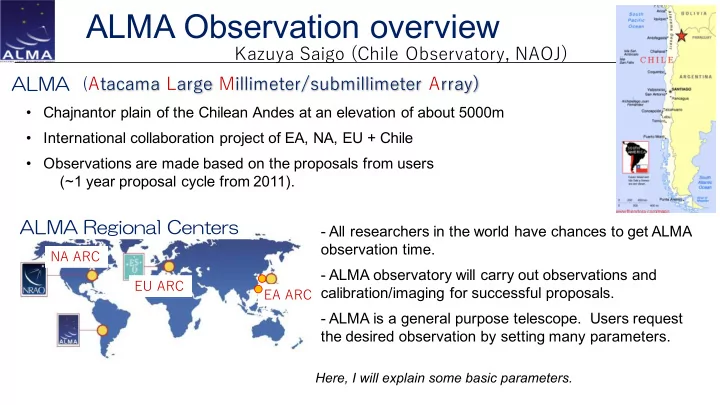

ALMA Observation overview Kazuya Saigo (Chile Observatory, NAOJ) ALMA ( Atacama Large Millimeter/submillimeter Array) • Chajnantor plain of the Chilean Andes at an elevation of about 5000m • International collaboration project of EA, NA, EU + Chile • Observations are made based on the proposals from users (~1 year proposal cycle from 2011). ALMA Regional Centers - All researchers in the world have chances to get ALMA observation time. NA ARC - ALMA observatory will carry out observations and EU ARC calibration/imaging for successful proposals. EA ARC - ALMA is a general purpose telescope. Users request the desired observation by setting many parameters. Here, I will explain some basic parameters.
Three important spatial scales I. Spatial Angular Resolution (AR) Spatial Angular Resolution is determined by antenna configuration and frequency. * AR ~ λ /L max where L max is the longest baseline length Interferometers can observe with extremely high spatial resolution. Maximum angular resolution ~0.02arcsec [ L max =16.2km, ν = 230GHZ ( λ =1.3mm)] Compact Antenna Configuration Extended Antenna Configuration North pole North pole V V L max L max U U
Examples of ALMA High Spatial Resolution Observation Protoplanetary Disks HL Tau Band 4 (continuum) AU scale hole in the TW Hydrae Band 7 (continuum) Disk Beam Size ~ 30 mas (1.6AU) 1 arcsec =140au Beam ~30mas (4au) ALMA Partnership et al., 2015, ApJ, 808, L3 Andrews et al., 2016, ApJ, 820,L40
Three important spatial scales II. Maximum Recoverable Scale (MRS) Maximum Recoverable Scale (MRS) and Largest Angular Scale (LAS) In principle, interferometer fail to sample information of the expanded structure. MRS is the largest smooth angular structure that can be obtained in a given array configuration ( ~ λ /L min L min is the shortest baseline length ). 30arcsec User requests the largest spatial scale that you want to obtain ( Largest Angular Scale =LAS ) Note that it is not a target source size. If it can not be obtained with a single array, ALMA observatory carry out multiple arrays observation.
Three important spatial scales III. Field of View (FoV) Field of View (FoV) In the interferometer observation, images can be obtained even with only single pointing observation. Sensitivity declines from the pointing center. FoV is a region (size) with sensitivity having higher than 50% of that of the central position. D ant Ex. FoV of 12m antenna at 230GHz is ~25arcsec * An image of a region larger than FoV can be obtained by Mosaic observation using multi pointing.
Key words for frequency setting • Band Observable range of each receiver ALMA telescope covers with a range of 84GHz 〜 950GHz by 7 receivers (Band3 - band 10) • SPW (Spectral Window) One frequency setting for observation (center frequency, frequency resolution). ALMA can observe multiple SPWs simultaneously.
www.almaobservatory.org The Atacama Large Millimeter/submillimeter Array (ALMA), an international astronomy facility, is a partnership among Europe, North America and East Asia in cooperation with the Republic of Chile. ALMA is funded in Europe by the European Organization for Astronomical Research in the Southern Hemisphere (ESO), in North America by the U.S. National Science Foundation (NSF) in cooperation with the National Research Council of Canada (NRC) and the National Science Council of Taiwan (NSC) and in Japan by the National Institutes of Natural Sciences (NINS) in cooperation with the Academia Sinica (AS) in Taiwan. ALMA construction and operations are led on behalf of Europe by ESO, on behalf of North America by the National Radio Astronomy Observatory (NRAO), which is managed by Associated Universities, Inc. (AUI) and on behalf of East Asia by the National Astronomical Observatory of Japan (NAOJ). The Joint ALMA Observatory (JAO) provides the unified leadership and management of the construction, commissioning and operationof ALMA.
Recommend
More recommend